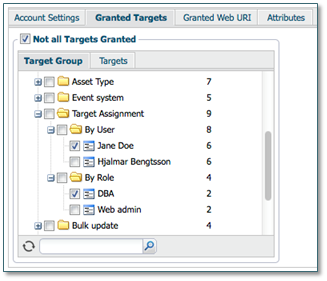Manage Users
Purpose
This document provides users with a comprehensive overview of the feature Manage Users for OUTSCAN and HIAB. This document has been elaborated under the assumption the reader has access to the OUTSCAN/HIAB account and Portal Interface.
Introduction
This document is a step-by-step configuration setup guide for configuring the OUTSCAN/HIAB solution according to best practice. It consider the size of the organizations and provide information about why different options are taken over other in order to provide justification why the different paths where chosen.
Users
The users are defined within the Main Menu > Settings > Manage Users in the lower left corner of the screen. When selected, a window is displayed showing an overview of the tree structure of the already defined users. Should none be defined then the leftmost field would only state Top level.
When considering setting up multiple users it is always good to investigate how to group them or perhaps have them organize themselves. Users can be created with sub users (and sub sub users) where access rights are inherited from the parent users. Meaning that if a user can add targets, then that user may be able to grant that access to sub users (unless he/she is not allowed to administrate users).
Depending on the size of the organizations there are different best practice in place but the main thing that applies to all of them are the following:
- Assign an individual account to all users – This is in order to get accountability. Users that understands that they have a personal account for which they are responsible will think before sharing such an account.
- Set up a password policy within the solution that matches the one in your company.
- Since this solution contains the discovered risks for your organization, if you have multiple password policies within your organization, choose the password policy accordingly.
- Before adding the users, see if there is any additional information that you which to have access to when managing the users. For example, business role such as Sys admin, DBA, Manager or likewise. The reason for this is that there is a role-based access system built into the tool and not having a clear view of the role of the users may cause trouble afterwards when the number of users grows.
- Within the system you can also define another user to be a Super user. This allows you to share the responsibilities of the tool should any of you go on a holiday or likewise. Verify that this is present and working prior to going abroad and communicate to whom they can turn to for questions to the rest of the users utilizing this tool.
Size of Organization
SMALL
Should the number of people be 1-5 that will be operating the tool, and all are working in a close group then it may be justified that all the people having access to the tool are Super users. Of course, giving more access than required is not best practice but setting to granular restrictions upon users within a small group may cause issues within the group itself. However, should a manager have access then that person can be created to only have access to the dashboard and given only read access to the tool in order to prevent any unwanted changes.
MEDIUM
When you have personal responsibilities for targets (like system owners) then it is wise to define groups within the target management section, which you then assign as granted targets to the individual users. Depending on the size of the network this can either be based on the user itself or a specific role. Like for example in the below picture, where Jane Doe is a user and a DBA, thus whenever a new database is added to the target group or if she becomes the owner of a new system then her access rights to that target will automatically be increased once the target group is updated.
LARGE
In a complex organization it may be required to assign targets to specific teams instead. Like Network Operational Center(NOC), Security Operational Center (SOC), Microsoft, or Linux team. These teams can then be individually divided into smaller groups if required. Appoint a single person responsible for the team by normal delegation of responsibilities within the user setup.
Cheat sheet – User
| Best practice | Goal | In place? | ||
|---|---|---|---|---|
| Yes | No | N/A | ||
Password policy defined | The password policy should reflect the company password policy for tools matching the same | |||
Add additional information on users | Include information prior to population for easier maintenance of larger set of users | |||
Add additional user with full rights | In larger organizations, have a stand-in for managing the tool in case of an emergency occurs where the main point of contact can’t be reached. | |||
Define target assignment groups | These groups are for ease the management of multiple users within the group without having to individually update each user when a new target is added to the vulnerability management program. | |||
Enforce two factor authentications | When 2FA is enabled then the user also needs to provide information from something they also have (one-time token) instead of just something they know (the password) and thus increasing the security. | |||
Force password change on initial login | Enforce that users change their password to a new one once they log in for the first time. This allows you to force the users to define their own password, which comply too the security policy defined by the tool and minimizing the impact on your preference or the automatic randomization of generated credentials. | |||
There are two ways of launching your applications.
From OUTSCAN
From a HIAB
OUTSCAN
To launch the OUTSCAN application, navigate to https://outscan.outpost24.com.
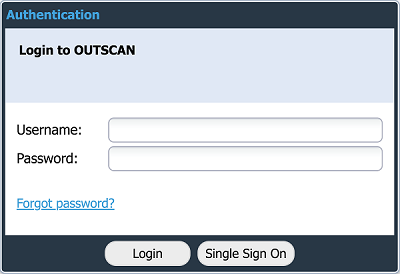
Login OUTSCAN
Log in using your credentials.
HIAB
To connect to a HIAB, use the assigned network address.
Use HTTPS protocol.
Ex. https://your-appliance-ip.
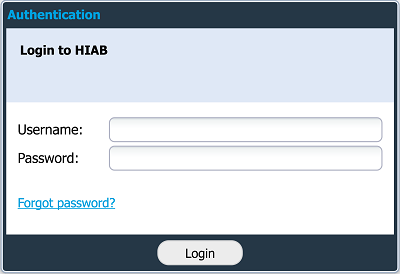
Login HIAB
Log in using your credentials.
Go to Main Menu > Settings > Manage Users to access the Manage Users feature. This area allows for viewing and editing of all the users that you administer in the system.
Manage User Accounts
The Manage User Accounts tab consists of the Groups tree and Users tree to the left, and a user grid to the right.
Groups
The Groups section shows a hierarchical structure of the defined user groups. The Groups section enable you to categorize users in different groups.
Clicking any group displays the users which are included in that specific group.
See Groups section for more information on how manage groups.
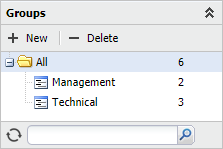
Filter: The Groups tree can be filtered by entering a partial or full name in the filter area at the bottom of the Groups tree section. This only show the groups that match the filtering string, and the parent accounts that are needed to show the hierarchy. Press the X-icon to clear the filter and show all groups again.
Users
In Users section, the Top Level represents your account and underneath a hierarchical structure of all the users that you can administrate is displayed. The usernames are shown in this tree. To select any user, click on the user name. This changes the user account grid to show only that user. Re-click to deselect that user.
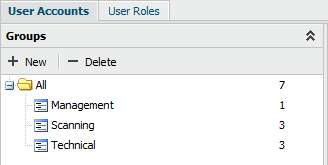
Filter: The Users tree can be filtered by entering a partial or full name in the search bar, located at the bottom of the Users section. This shows only the users that match the filtering string, and the parent accounts that are needed to show the hierarchy. Click on the X button, to clear the filter and show all users again.
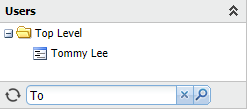
User Accounts Grid
The User Accounts grid shows detailed information about the users. It is possible to add or remove columns in this grid.
To add or remove columns:
- Click on the arrow ▼ beside any column name to view the drop-down menu.
- Choose Columns, and select the columns that you wish to add.
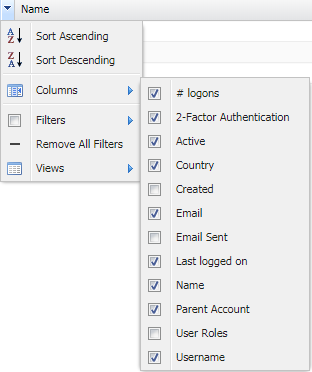
Below you find a list of the different columns available.
Option | Description |
Logons | Displays how many times the user has logged into the system. |
2-Factor Authentication | What sort of 2-factor authentication the user is using. |
Active | If the account active or not. |
Country | The users’ country. |
Created | The date and time when the account was created. |
The email address of the user. | |
Email Sent | The last time an information email or password recovery email was sent to the user. |
Last logged on | When the user last logged into the system. If this entry is blank the user has still not logged into the system. |
Name | The full name of the user. |
Parent Account | The parent account of the user account. Top Level means that your account is the parent. |
User Roles | The type of user roles assigned to the user. |
Username | The username that the user logs into the system with. |
Right clicking on a user brings up a context menu where specific actions on that user or view can be performed.
Option | Description |
New | Opens the Create new user window. |
Delete | Deletes the selected user. |
Edit | Change details on the selected user. |
Copy | Copies the selected user's base settings, and open a new user where the general information needs to be filled in. |
Export | Export all user accounts as a CSV or HTML file. |
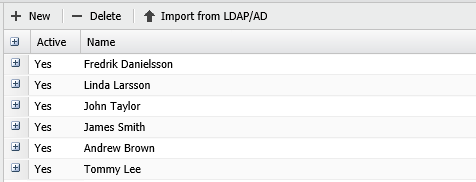
By clicking on the expand icon or double click on a user displays additional information about the user account.

Manage Users
Prerequisites
User Roles need to be created before the user to be available for selection.
See User Roles for more information on how to create roles.
Create a User
To create a user:
Click Main Menu > Settings > Manage User.
In the Manage User Accounts window select User Accounts tab.
The buttons at the top center of the screen ids used to create, delete, or import users from LDAP/AD.
The Import from LDAP/AD function is only available on HIAB. See LDAP/AD user guide for more information on setting up and mapping users in LDAP.
Click + New to create a user.
In the Maintaining User Account window, fill in the Account Details and Login Details.
In the grid on the lower half of Maintaining User Account window, the account access and rights can be further set up in the different tabs. Note that the tabs differs depending on your license.
Account Details
Option | Description |
|---|---|
Parent Account | Sets the parent account, could be used to create hierarchy structures. |
First name | The first name of the user. |
Last name | The last name of the user. |
A valid email address to the user. | |
Mobile number | The mobile number of the user. |
Country | The country of the user. |
State | The state of the user (Active if Country is United States). |
Email PGP public key | Select PGP public key or click the + sign to upload a PGP key.
|
Login Details
Option | Description |
|---|---|
Authentication (HIAB Only) | Choose if the user credentials should be verified against the local database or the defined LDAP or Active Directory server. |
Username | Enter a username. |
Password | Enter a password, or generate a password using the password button. Passwords are generated according to the password policy located in the Security Policy tab under Main Menu > Settings > Account. See section Password Policy in Account Settings document for information on how to set password policies. |
Password again | Confirm the password by re-typing in this field. |
Require password change on next logon | If enabled, forces the user to change his/her password the next time they log in to the system. |
2-Factor Authentication | If enabled, you may set up the mode of authentication from here. Mobile Security Code or Google Authenticator can be used for authentication. The method used for authentication can be limited, depending on the options configured for two factor authentications in the security policy. When Google authentication is selected, you will be asked to enter the credential ID which is used to set up the account. |
In Account Settings tab you can deactivate an account and set the users notification.
Option | Description |
|---|---|
Active | Activate or deactivate account. |
Super User | A user with Super User enabled will have the same rights as the main account (which is unrestricted). |
Receive System Notifications | When Super User is active, the user can receive system notifications, or have it deactivated. |
Allow Enroll HIAB | Allow the user to enroll HIABs. |
Send Informative Email | If Send Informative Email is activated, then the system will send an email to the sub user when their account has been changed. |
Escalate tickets to | The Escalate tickets to drop down menu allow you to define who should receive any tickets which has not been resolved prior to its due date (which were assigned to this specific user). |
Assign the user with one or more Granted User Roles otherwise the user will not be allowed to perform any actions in the system.
For more information on how to create user roles, see User Roles.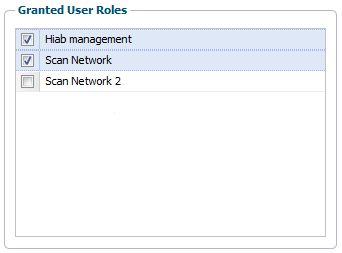
In the Granted Targets tab, you can define which targets and scanners (if enabled) the user should have access to.
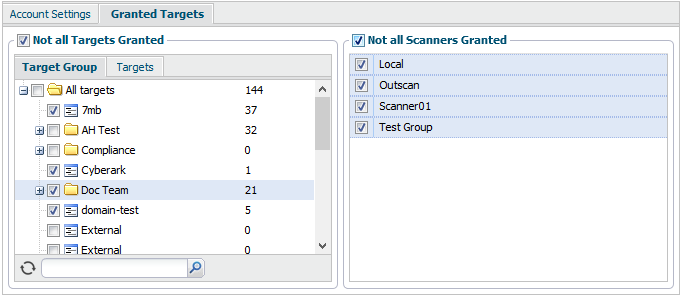
Not all Targets Granted limits the target groups and targets a user can see and administrate. The target list feature should be used sparsely since it create an overhead when it comes to administrative task in the long run. The only time you should use this feature is when you would like to grant access to a whole IP range without having to define all targets within the system.
Not all Scanners Granted works in a similar way as Not all Target Granted and limits the scanners a user can see and administrate.
Once the user has been set up, click Save.
Groups
The Groups function enable you to bundle users together into simple groups to be presented in the group grid.

Note
Roles cannot be applied to groups, roles can only be applied on a user level.
Create Groups
To create a new group, click the + New option, or right click and All folder in the Groups tree and choose New.


To create a new subgroup, select a main group and click the + New option, or right click the group name and select New in the menu.
Manage Groups
Populate Groups
Once a group is created, it can be populated with users.
To populate a group:
- Select the users by pressing Ctrl + Left click on each user in the User Account grid and drag them to the designated group.
Note
A user can only be part of one group.
Moving Users Between Groups
Users can be moved freely between groups.
To move users to another group:
- Click the the group where the user resides in to list the group content in the User Account grid.
- Select the users by pressing Ctrl + Left click on each user you want to move. Then drag the user/users into the new group.
Note
Users connect to a top level user will not be moved together with the top level user. Each user need to be moved individually or as a selected group.
Delete Groups
To delete a group, select the group in the Groups section, and click – Delete option, or right click the group and select Delete in the menu.
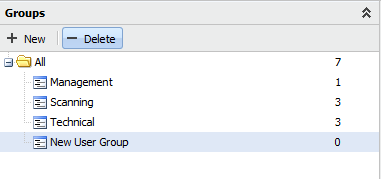
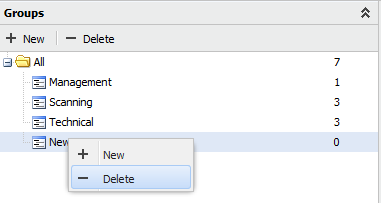
Note
Deleting a group do not delete the users within the group. They go back to All folder .
User Roles
Create Roles
To create a user role:
Click Main Menu > Settings > Manage User.
In the Manage User Accounts window select User Roles tab and click + New.
In the Maintaining User Role window, enter a Role Name.
Select the various boxes to match the role being created.
Click Save.
Maintaining User Role
Option | Description |
Role name | Every user role needs to have a given name to identify the role. |
Read Only | The user will not be permitted to make any changes or new creations when this option is enabled. |
LDAP/AD Group (HIAB only) | The LDAP/AD Group field is available if LDAP/AD is enabled on the HIAB. This user role is mapped to the defined role in LDAP/AD when the user login. |
Target Management

Option | Description |
Administrate Targets/Target Groups | Allows the user to administrate targets and groups in the Manage Targets view. |
Scan Scheduling
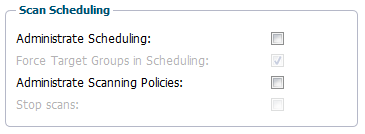
Option | Description |
Administrate Scheduling | Determines if the user can define and set up new scan schedules. |
Force Target Group in Scheduling | Enforces the user to only use the already defined groups in the scheduling section. No manual targets can be entered in the targets tab. |
Administrate Scanning Policies | Determines if the user can create, modify and remove scanning policies within the system. |
Stop scans | If the user can administrate scan scheduling they will also be allowed to stop scans if this setting is enabled. |
Reporting Tools
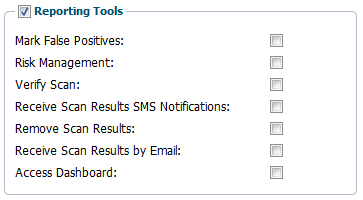
The Reporting Tools field gives a user permission to view the reporting tools. If not enabled, the reporting tools are not shown to the user.
Option | Description |
Mark False Positives | Allow the user to mark a finding as a false positive. |
Risk Management | Allow the user to mark vulnerabilities as accepted risks and/or change the risk level for a finding. |
Verify scan | Allow the user to perform verification scans. No scans will be deducted from the license when using this feature. |
Receive Scan Results SMS Notifications | Enable the user to receive scan results as SMS. |
Remove Scan Result | Allow the user to remove reports. |
Receive Scan Results by Email | Enable the user to receive reports by email. |
Access Dashboard | Allow the user to see the Dashboard. |
Compliance Scanning
Compliance Scanning is only visible if it is included in your license.
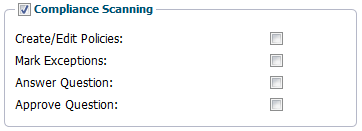
The Compliance Scan field gives a user, permission to view the Compliance scanning module.
If not enabled, it will not be shown to the user.
Option | Description |
Create/Edit Policies | Allow the user to Create/Edit policies. |
Mark Exceptions | Allow the user to mark exceptions. |
Answer Question | Allow the user to answer questions. |
Approve Question | Allow the user to approve questions. |
Web Application Scanning
Web Application Scanning is only visible if it is included in your license.

Option | Description |
|---|---|
Administrate Scoping | Allow the user to administrate Scoping. |
Access Reporting | Allow the user to access reporting. |
Remove Scan Results | Allow the user to remove Scan results. Access Reporting needs to be selected for this role. |
Scoping
Outscan only

Option | Description |
|---|---|
Submit scoping request | Allow the user to submit Appsec scoping requests. |
PCI Management
PCI Management is only visible if PCI Compliance scan is included in your license.
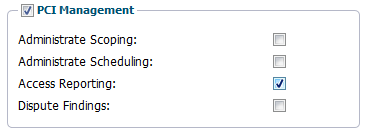
Option | Description |
Administrate Scoping | Allow the user to create, modify, or remove any scopes in this module. |
Administrate Scheduling | Allow the user to start and stop PCI scans. |
Access Reporting | Allow the user to view PCI reports. |
Dispute Findings | If the user has Access Reporting this option allow the user to dispute findings from the report. |
Managed Reports
This section is only visible if you have an Managed Reports license.

Option | Description |
Comment Reports | Allow users to add comments to reports. |
Vulnerability Management

Option | Description |
Comment Vulnerability Database | Allow the user to create and edit comments in the vulnerability database. |
User Management

Option | Description |
Administrate Accounts | Allow the user to administrate accounts. |
Administrate User Roles | Allow the user to administrate user roles. |
Ticket Management

Option | Description |
Manage Tickets | Allow the user to administrate tickets. |
Grant All Tickets | Give access to all internal tickets. (If Manage Tickets is selected). |
Audit Log Management

Option | Description |
Read Audit Logs | The user is able to read the auditing log. |
License

Option | Description |
View License | Allow the user to view the License tab in Main Menu > Settings > Account. |
HIAB Management (HIAB only)
HIAB Management only visible if it is included in your license.

Option | Description |
Administrate HIAB Server | Allow the user to restart the HIAB and setup HIAB settings like backup and networking. |
Attributes
The Attributes tab is available only if they are set to active. See Attributes section in Account Settings document for information on how to set attributes.
Note
The tabs in the lower half of the window varies depending on your license.
Related Articles
Copyright
© 2026 Outpost24® All rights reserved. This document may only be redistributed unedited and unaltered. This document may be cited and referenced only if clearly crediting Outpost24® and this document as the source. Any other reproduction and redistribution in print or electronically is strictly prohibited without explicit permission.
Trademark
Outpost24® and OUTSCAN™ are trademarks of Outpost24® and its affiliated companies. All other brand names, product names or trademarks belong to their respective owners.

